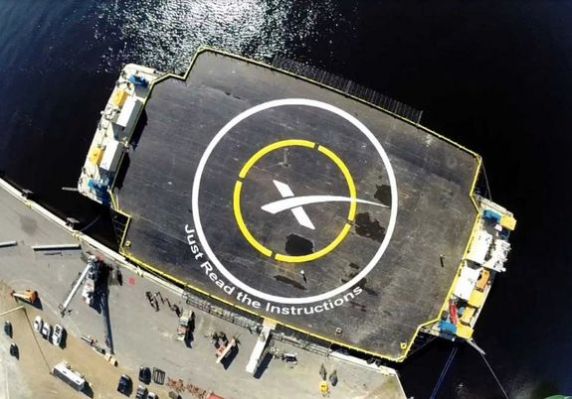SpaceX has confirmed that they will attempt another, more difficult, rocket landing on their next launch January 17th. Their Falcon 9 is scheduled to lift off from Vandenberg Air Force Base in California with NASA’s Jason-3 satellite on board. This time the rocket will be returning to a “drone ship” (an autonomous floating platform) in the ocean rather than a launchpad on land like their last successful landing on December 21st.
If they succeed, it will be the first successful rocket landing in the sea. Elon Musk named the autonomous drone ship “Just Read the Instructions” as a nod to the fictional starships in sci-fi novels written by the late Iain M. Banks. Just Read the Instructions, which was used in the previous SpaceX landings from Cape Canaveral, has been restored, modified and brought over to the West Coast for this launch.
Landing a rocket on a floating drone ship at sea is much more difficult than landing it on stable ground. The sea itself is constantly in motion, which means you’re trying to land an already unstable rocket on a slightly unstable platform. When landing a rocket, so many things can go awry, so you’d really want to limit the number of variables that are constantly changing.
It seems that it would make more sense for SpaceX to use its next few launches to continue to perfect the less difficult, but still incredibly complex, strategy of ground-based rocket landing.
There’s a few reasons why SpaceX may be changing up the landing location for its next flight. For one, it’s simply safer to test out this technology away from populated areas. SpaceX’s first two landing attempts, which were on drone ships, were close to sticking the landing but ultimately ended in explosions.
Explosions make people nervous. NASA, who is paying for this particular SpaceX flight, is potentially less willing to take risks than SpaceX. So even if SpaceX wanted to bring its rocket back to land, they may not have been able to get it approved.
The December 21st flight took place at Cape Canaveral and was commissioned by the private company Orbcomm. It’s possible that there are simply different policies in place for this launch.
If SpaceX can stick this second landing, it will be even more impressive than the first. Perfecting the ability to land a rocket on a drone ship in the sea will give them greater flexibility for future launches. Depending on where they launch and who’s calling the shots, it may not always be possible to bring their rocket back to land. A drone ship can also move its location and theoretically optimize for the safest, most efficient landing spot.
The recovered first stage from December will not be used in this launch. Musk has stated that while the recovered rocket from the December launch was in good condition, it will not likely be used again.
The new Falcon 9 rocket used for this January 17th launch is scheduled to have a static fire test on Saturday, January 9th. The payload fairing will then be mated to the rocket on Tuesday, January 12th.
If California’s El Nino rain fails to delay the launch, we’ll all have another highly anticipated SpaceX rocket landing to look forward to next week.
